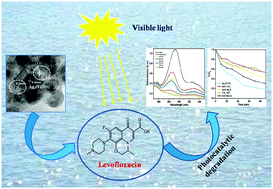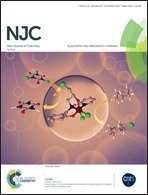Visible light driven photocatalytic degradation of fluoroquinolone levofloxacin drug using Ag2O/TiO2 quantum dots: a mechanistic study and degradation pathway†
Abstract
Herein, we report the facile synthesis, characterization and photocatalytic degradation application of Ag2O/TiO2 quantum dots (QDs). The QDs were synthesized via a pH-mediated precipitation method and characterized in detail in terms of their morphological, compositional, structural, optical and photocatalytic properties. Detailed morphological studies confirmed the large scale formation of spherical Ag2O/TiO2 quantum dots with typical sizes of 2–9 nm. Surface analysis by XPS clearly revealed the presence of Ag+ and Ti4+ in the form of Ag2O and TiO2. Optical properties exhibited an absorption shift towards the visible light region i.e. 506 nm, a wide shift compared to TiO2 QDs (i.e. 394 nm) in the synthesized Ag2O/TiO2 QDs. As a photocatalyst, the synthesized material exhibited remarkable photocatalytic performance towards the degradation of levofloxacin drug under visible light as compared to bare TiO2. The higher photocatalytic activity was due to electron–hole pair separation which improved the light absorption (λ > 400 nm) and availability of active sites. Interestingly, the major intermediates of levofloxacin degradation were identified and a probable pathway was also proposed. The observed results clearly revealed that simply prepared Ag2O/TiO2 QDs could be an excellent candidate for the photocatalytic degradation of various harmful chemicals.



 Please wait while we load your content...
Please wait while we load your content...